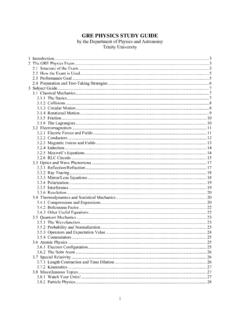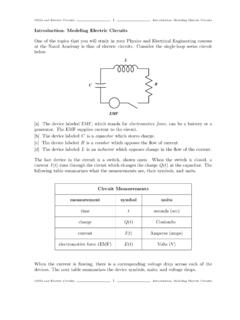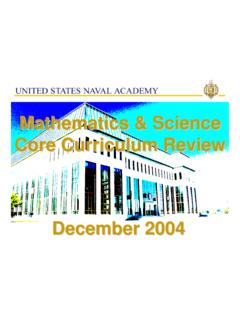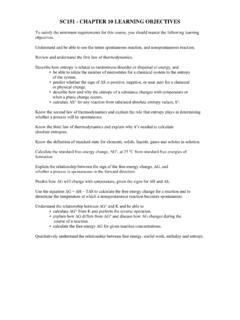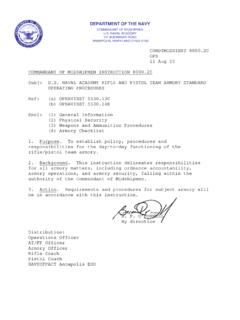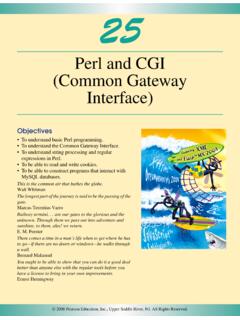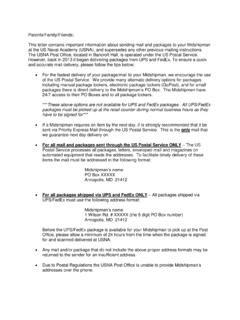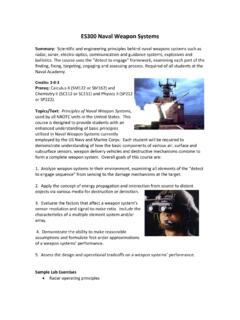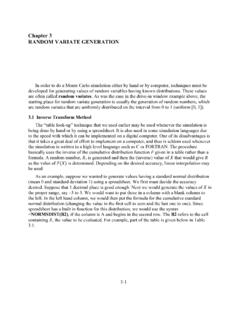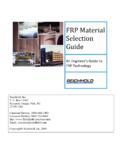Transcription of Common Lay-up Terms and Conditions - United States Naval ...
1 2003, P. JoyceCommon LayCommon Lay--up Terms and up Terms and ConditionsConditions Mid-Plane: Centerline of the Lay-up . Plane forming the mid-line of the laminate. 2003, P. JoyceCommon LayCommon Lay--up Terms and up Terms and ConditionsConditions Symmetry: A laminate is symmetric when the plies above the mid-plane are a mirror image of those below the mid-plane. Symmetrical lay-ups help to avoid thermal twisting of parts as they cool down after curing. 2003, P. JoyceCommon LayCommon Lay--up Terms and up Terms and ConditionsConditions 2003, P. JoyceCommon LayCommon Lay--up Terms and up Terms and ConditionsConditions Balance: A laminate is balanced when it has equal numbers of and + angled plies.
2 2003, P. JoyceCommon LayCommon Lay--up Terms and up Terms and ConditionsConditions Warp ClockThe Warp Clock is the standard for determining ply orientation. It is also how and + angled plies are defined. The 0 axis is always parallel to the long direction of the structure or rectangular panel. The 90 axis is always perpendicular to the 0 axis. The 45 axis may be determined in two different ways: 2003, P. JoyceCommon LayCommon Lay--up Terms and up Terms and ConditionsConditionsCounter ClockwiseManufacturing are viewed from the inside of the structure looking towardthe tool surface. +45 is located by moving counterclockwise from 0 to 90 . 2003, P. JoyceCommon LayCommon Lay--up Terms and up Terms and ConditionsConditionsClockwiseRepair are viewed from the outside of the structure, or the tool surface, looking in.
3 +45 is located by moving clockwise from 0 to 90 . 2003, P. JoyceCommon LayCommon Lay--up Terms and up Terms and ConditionsConditions Quasi-isotropic Isotropic means having the same properties in all directions. Quasi-isotropic means having isotropic properties in-plane. A quasi-isotropic part has either randomly oriented fiber in all directions, or has fibers oriented such that equal strength is developed all around the plane of the part. Generally, a quasi-isotropic laminate made from woven fabric has plies oriented at 0 , 90 +45 and 45 , with at least of the plies in each of these four directions. Quasi-isotropic properties can also be achieved with 0 , 60 and 120 oriented unidirectional plies.
4 2003, P. JoyceQuasiQuasi--isotropic laminateisotropic laminate 2003, P. JoyceLaminate Orientation CodeLaminate Orientation Code The purpose of the laminate orientation code is to provide a simple easily understood method of describing the Lay-up of a laminate. The laminate orientation code is based largely on the code used in the Advanced Composites Design guide Shorthand to condense a long descriptive representation of a multi-layer laminate into as few symbols as possible. Used during engineering analysis and for other non-drawing uses. 2003, P. JoyceLaminate Orientation CodeLaminate Orientation Code Laminaeare listed in sequence starting from the tool surface or surface indicated by the leader arrow Each lamina is labeled by its ply orientation Each lamina is separated by a slash Multiple laminaeof the same angle are indicated by a subscript, indicating the number of plies, following the angle indication.
5 2003, P. JoyceLaminate Orientation CodeLaminate Orientation Code Repeating groups of plies within a laminate can be placed in parentheses. Each complete laminate is enclosed in a set of brackets Symmetric laminates with an even number of plies are representedby listing all plies on one side of the mid-plane enclosed in brackets, followed by the subscript "s". Symmetric laminates with an odd number of plies are listed with a bar over the center ply to indicate it is the mid-plane 2003, P. JoyceLaminate Orientation CodeLaminate Orientation Code Unidirectional Laminae 45 indicates two unidirectional plies starting with a +45 followed by a -45. + 45 indicates two unidirectional plies starting with a 45 followed by a +45.
6 Fabric Laminae Fabric plies are identified by either an "F" following the ply angle or the ply may be placed in parentheses. The angle value represents the direction of the warp fibers. 45F indicates a woven fabric placed at either a + or 45 direction. + 45F indicates that the warp fiber must be placed in the +45 direction. 2003, P. JoyceReferencesReferences Engineering Mechanics of composite Materials, Daniel, and Ishai, O., 1994. Mechanics of composite Materials, Jones, , 1999. Mil-Hdbk-17 composite Materials Handbook, 1997.
